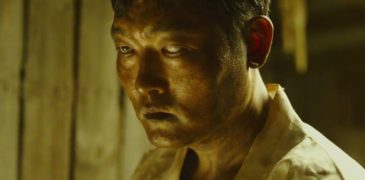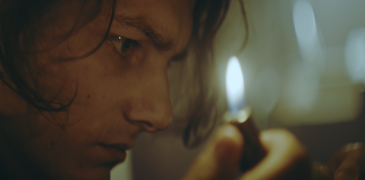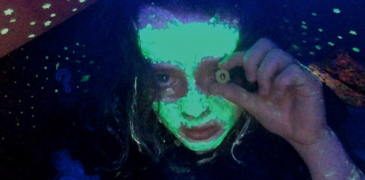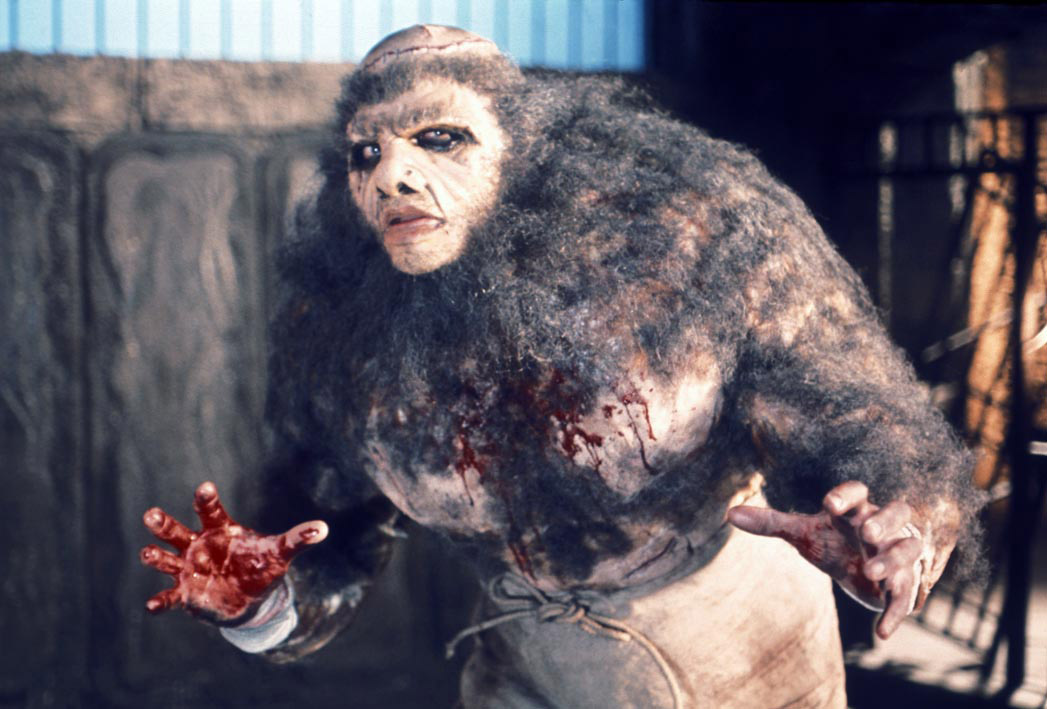
In 1934, vaudevillian Will Hammer (real name William Hinds) diversified into the film industry. Hammer Productions Limited joined forces with Spanish entrepreneur Enrique Carreras to create Exclusive Films Limited, before returning to the Hammer name two decades later. 1955 saw the release of The Quatermass Xperiment, an adaptation of the wildly successful BBC series. Quatermass revitalized Hammer’s image, and after two more science-fiction films, they produced their first in the Gothic horror genre: The Curse of Frankenstein. Loosely adapted from Mary Shelley’s classic novel, it was the first British horror film to be shot in colour, and the first in Hammer’s Frankenstein series. Helmed by Terence Fisher (who directed a slew of Hammer films, including all but two Frankensteins), Frankenstein and the Monster from Hell is the seventh and final in the series.
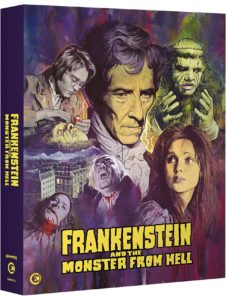
Simon Helder (Shane Briant) is a young surgeon obsessed with the work of Baron Frankenstein (Peter Cushing, in his sixth outing as the Baron). Discovered in the midst of a grisly autopsy and accused of sorcery, Simon is sent to an insane asylum: the same asylum to which Frankenstein himself was committed for similar crimes. There, he learns that Frankenstein faked his death and blackmailed the asylum so that he could continue his experiments undetected. Simon eagerly becomes his assistant, and the quest to build a man begins. At first, they are united in the endeavour, but then Simon discovers just how far Frankenstein is willing to go.
At some point, the filmmakers must have realised that their story needed a hero. They attempt a redemption arc for Simon, but it falls flat, not least because he is introduced as a callous, superior man who enjoys dismembering corpses. It seems more than a little hypocritical for a graverobbing obsessive to balk at the idea of rape or murder. Meanwhile, he is falling in love with Sarah (a thankless role for Madeline Smith). Mute and traumatised, she assists Frankenstein in his experiments and becomes the ‘angel’ of the asylum. Usually, Hammer horror films offer a bevy of buxom beauties to heave their bosoms and faint and scream. When these women are not villainous lesbian vampires, they are often little more than set dressing. There is nothing of the sort here. Despite her essentially pointless role, the filmmakers at least respect Sarah’s trauma enough not to sexualize or exploit her. Smith does what she can with the character, but Sarah exists solely to inspire the men around her.
Had the film not tried to send Simon on a hero’s journey, it would be much stronger. John Elder’s script (revised by Fisher and producer Roy Skeggs) understands that sometimes, there are no ‘good guys’. Sometimes, there are only villains and victims. Towards the beginning of the film, a judge despairs that a man of Simon’s “breeding and education” could stoop to grave robbery and human experimentation. Of course, only men of Simon’s background can ever get away with crimes so heinous. The insane asylum is patently grim. From sadistic guards to a predatory director, it is riddled with systemic failures. In one scene, recalling the Georgian pastime of ogling patients at Bedlam, a visitor begs to see “the lunatics”. The film also offers insight into what sorts of people would be considered ‘insane’ at this point in time. Violent men rub shoulders with delusional but ultimately harmless patients; one man’s implied ‘sickness’ is homosexuality (played for laughs, but nonetheless an important inclusion). Sadly, the film stumbles in the end, reducing the victimized patients to a braying, ravenous mob, and robbing them of much of the sympathy they so clearly deserve.
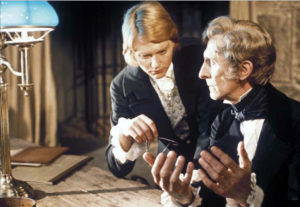
After the critical failure of the previous Frankenstein film, Peter Cushing returned to appear as the baron one final time. He is, as always, magnetic. A true thespian, for a while Cushing was typecast in villainous roles, though his turns as Sherlock Holmes and Van Helsing offered heroic interludes. He embraced villainy, however, and treated each role like Shakespeare. He was wholly invested in the success of the film. During production (which lasted just over two months in 1972), he requested specific surgical tools for the Baron and even offered script rewrites. By this time, he had played Frankenstein for almost two decades, and his instincts were as sharp as Fisher’s, if not sharper. Frankenstein and the Monster from Hell presents a weary Baron. Narratively, his previous failures – exacerbated here by badly burned hands that preclude him from performing surgery – weigh heavily upon him. In real life, Cushing had recently lost his wife. The change in his physical appearance was so stark that even the shooting script describes the baron as “older and [showing] signs of strain.” Cushing retains the cold, calculating, demented air, but adds a layer of introspection: fitting for his final outing in the role.
If nothing else, Hammer can always be relied on for sumptuous sets and sweeping scores. Frankenstein and the Monster from Hell is no exception. Despite much of the film taking place in the dank cells of the lunatic asylum, it always looks fabulous. Hammer mainstay James Bernard provides the score and sets the tone perfectly. From the beginning, Hammer horror films pushed the limits of what the censors – and the general public – could stomach. The BBFC requested they cut a scene of a head dissolving in acid from their first Frankenstein film; the scene has now been lost. The ’70s amped up blood and sex, starting with the wildly controversial The Vampire Lovers. Frankenstein and the Monster from Hell play surgery scenes deathly straight. Saws scrape along bone, and Frankenstein holds delicate arteries in place with his teeth. (Allegedly, the blood in Cushing’s mouth is real.) Brains, blood, and assorted viscera take centre stage. The only stumble is the creature design. Played by Dave Prowse (Darth Vader himself), he is a pitiable, compelling figure, and from the neck up, the tragedy carries. Sadly, the costume looks rubbery, and the hair is clearly glued in place.
Frankenstein and the Monster from Hell was not a commercial success. In its first week at the London Astoria, it took £1,774 (less than £14,000 today) – just over 1% of what it cost to make. A far cry from The Curse of Frankenstein, which broke records in its first weekend, and went on to gross over seventy times its production costs. Of course, times had changed. What was once ground-breaking had become old hat. Creature features had fallen out of favour, and films like The Exorcist (1973) were pushing horror in a new direction. Still, there is much to recommend about Frankenstein and the Monster from Hell – from Cushing’s performance to the reliably sumptuous set design, and the effectively grisly surgery scenes. While it is by no means the strongest entry in Hammer’s Frankenstein series, it offers an interesting, melancholic, almost reflective experience. Not only does the film include Cushing’s last performance in an iconic role, but it is also director Terence Fisher’s swansong. Second Sight Films have lavished the upcoming rerelease with special features and content.

Special Features
- Main feature presented in original UK theatrical aspect ratio 1.66:1 and alternative full frame 1.37:1
- New audio commentary by film academic Kat Ellinger
- Archive audio commentary by Shane Briant, Madeline Smith and Marcus Hearn
- An appreciation of Frankenstein and the Monster from Hell by David Huckvale
- The music of Frankenstein and the Monster from Hell
- Taking Over the Asylum
- Charming Evil: Terence Fisher at Hammer
- Stills gallery
Limited Edition Contents
- Rigid slipcase with new artwork by Graham Humphreys
- Soft cover book with new essays by Kevin Lyons, Kelly Robinson and Emma Westwood plus production stills
- 5 collectors’ art cards
Frankenstein and the Monster from Hell releases August 29th and is available to pre-order now. Grimoire of Horror thanks Second Sight Films for providing a copy of the film in exchange for an honest review.
More Film Reviews
In the summer of 2009, a Korean blogger claimed to have seen a strange creature near Jangsan, a mountain in Busan. The following year, the creature was spotted again. As… Heroin addict Charlie (George Webster) has been going to group therapy, though secretly showing up just to meet with his dealer. When a young woman joins the therapy session Charlie… A lonely and awkward teen joins a viral internet fad called The World’s Fair Challenge, said to potentially change you mentally and physically. After taking the challenge she begins to… Preman is a 2021 Indonesian action crime drama, written and directed by Randolph Zaini in his first feature length directorial debut. After witnessing the murder of an old man at… Considering the popularity of monster movies being rekindled by Godzilla Versus Kong (2021), the newest entry into the ‘MonsterVerse’, the classic approach to this genre may be coming into a… M. Night Shyamalan’s Latest is Mediocre Old (2021) is an existential story about a beautifully secluded beach surrounded by rocks that will kill you, eventually. M. Night Shyamalan’s newest release…The Mimic (2017) Film Review – South Korean Urban Legend
God’s Petting You (2022) Film Review – Dark and Dirty British Comedy
We’re All Going to the World’s Fair (2021) Film Review – Getting Lost Online
Preman (2021) Film Review – Indonesian Action Crime Drama
Abyssal Spider (2020) Film Review – Deep-Sea Arachnophobia
Old (2021) Film Review – Spoiler Free!
Isabelle is a writer from the UK who enjoys alternative manga and horror films. When not writing, you can probably find Isabelle buying books or obsessing over Martin and Lewis.
